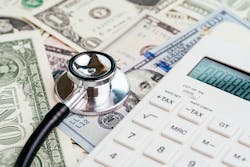The Medicare Program’s Actuaries have released their latest estimates of U.S. healthcare system spending trends, and the news is mixed, with the percentage of GDP (gross domestic product) devoted to healthcare spending dipping slightly, but with the healthcare inflation rate rising slightly.
The results of the Medicare actuaries’ latest study appeared on December 5 in an article published on Thursday afternoon in Health Affairs online.
The authors of the article are Micah Hartman, Anne B. Martin, Joseph Benson, and Aaron Catlin, all statisticians, economists, and administrators in the CMS (Centers for Medicare & Medicaid Services) Office of the Actuary.
“U.S. health care spending increased 4.6 percent to reach $3.6 trillion in 2018, a faster growth rate than the rate of 4.2 percent in 2017 but the same rate as in 2016,” the Medicare actuaries wrote. “The share of the economy devoted to health care spending declined to 17.7 percent in 2018, compared to 17.9 percent in 2017. The 0.4-percentage-point acceleration in overall growth in 2018 was driven by faster growth in both private health insurance and Medicare, which were influenced by the reinstatement of the health insurance tax. For personal health care spending (which accounted for 84 percent of national health care spending), growth in 2018 remained unchanged from 2017 at 4.1 percent. The total number of uninsured people increased by 1.0 million for the second year in a row, to reach 30.7 million in 2018.”
As the Medicare actuaries noted:
“Much of the faster spending growth in 2018 was associated not with expenditures for goods and services but instead with the net cost of health insurance (the amount of insurance spending attributed to nonmedical expenses, including administration, taxes, and underwriting gains or losses). The net cost of health insurance grew more rapidly in 2018, increasing 13.2 percent after growing 4.3 percent in 2017.2 The faster growth in 2018 was driven primarily by the health insurance tax, a fee that was reinstated in 2018 following a one-year moratorium in 2017.3,4 This fee was imposed on all health insurance providers beginning in 2014 as part of the funding for the Affordable Care Act (ACA). The Consolidated Appropriations Act of 2016 instituted a one-year moratorium on it for 2017.
The growth rate for total personal health care spending (expenditures for health care goods and services) was the same in 2017 and 2018 (4.1 percent) (exhibit 2). That spending accounted for 84 percent of total national health expenditures in 2018. Its stable growth of 4.1 percent in 2018 reflected mixed trends in the three largest goods and services categories: hospital care, physician and clinical services, and retail prescription drugs. Together, spending for these categories accounted for 73 percent of total personal health care expenditures. Hospital spending growth was similar in 2017 and 2018, at 4.7 percent and 4.5 percent, respectively. For physician and clinical services, spending growth slowed from 4.7 percent in 2017 to 4.1 percent in 2018, while growth in retail prescription drug spending increased from 1.4 percent in 2017 to 2.5 percent in 2018.”
Importantly, relative to federal healthcare policy development at the Department of Health and Human Services and CMS, “For the federal government, spending growth on health care accelerated in 2018 to 5.6 percent, compared to a rate of 2.8 percent in 2017. The acceleration in 2018 was driven mainly by faster growth in the federally sponsored portion of expenditures for the Medicare program (a 32 percent share), which increased 6.5 percent in 2018 compared to 1.3 percent in 2017. Furthermore, growth in spending on the federal portion of Medicaid payments (a 36 percent share) accelerated to 3.2 percent in 2018 after growth of 0.3 percent in 2017—the first year that states were required to fund 5 percent of the spending for the Medicaid expansion population. In the years before 2017, these costs were funded entirely by the federal government.”
Meanwhile, the actuaries noted, “For state and local governments, spending on health care grew more slowly in 2018, increasing 2.5 percent after a rate of 3.6 percent in 2017. The deceleration in 2018 was driven by slower growth in state and local Medicaid spending (which represented 38 percent of total health spending for state and local governments). State and local Medicaid spending grew 2.6 percent in 2018 after growing 6.5 percent in 2017—again reflecting the increased state funding responsibility for the expansion population discussed above.”
Importantly also, “Private health insurance expenditures accounted for 34 percent of total national health care spending in 2018 and reached $1.2 trillion,” the actuaries noted. “Spending in this category increased 5.8 percent in 2018, which was a faster rate than the 4.9 percent growth experienced in 2017. Private health insurance spending for medical goods and services grew 4.5 percent in 2018, similar to the growth rate of 4.3 percent in 2017, while the net cost of private health insurance (which represents 64 percent of the total net cost of health insurance) increased rapidly in both years—9.5 percent in 2017 and 15.3 percent in 2018.”
And, they said, “The 4.5 percent growth in medical goods and services paid for by private health insurance reflected mixed trends in underlying goods and services, as spending for hospital care, retail prescription drugs, dental services, and other professional services grew more rapidly in 2018 while spending growth for physician and clinical services, nursing home care, home health care, and durable medical equipment decelerated.”
This report did not include future projections around total future U.S. healthcare expenditures, but on February 20 of this year, the actuaries predicted that total national healthcare expenditures would grow to nearly $6 trillion by 2027, and consume 19.4 percent of GDP by 2027, compared to 17.9 percent in 2017.


